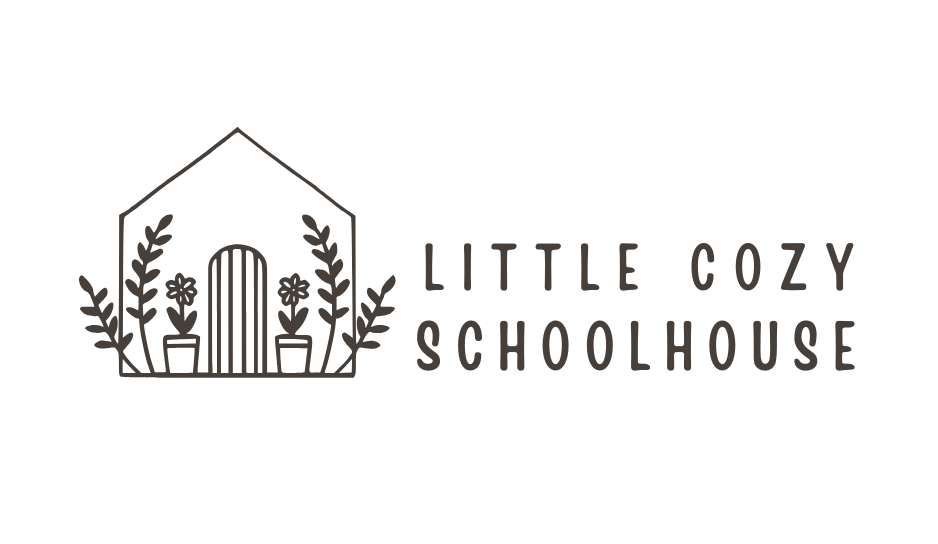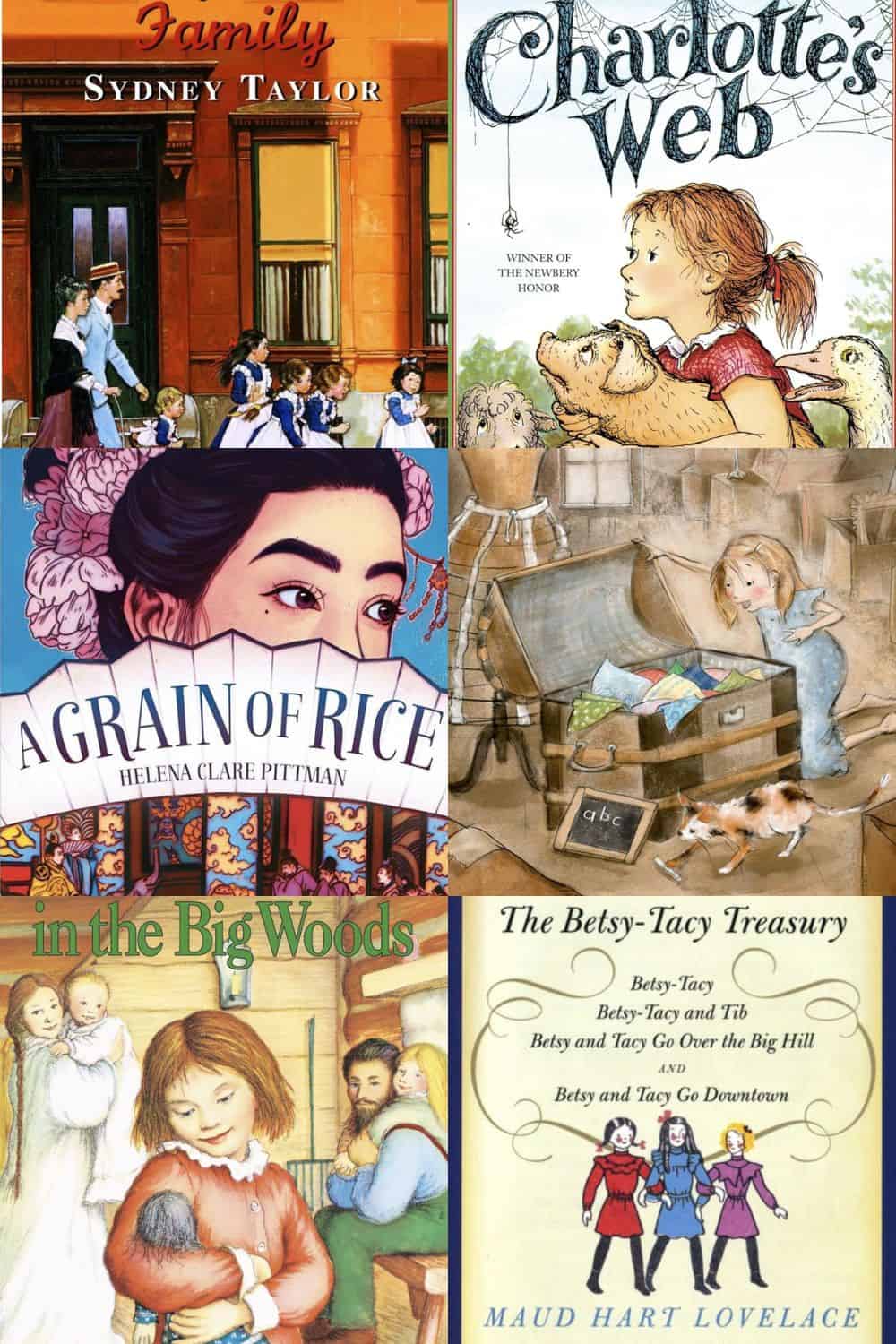Creative Ways to Store Kids Books
As a homeschool family, we’ve collected a LOT of children’s books! It’s fun to build a collection of our favorites, but storing them quickly becomes overwhelming. This is a list of my top ways to store kids’ books–even if you have limited space or a small home.
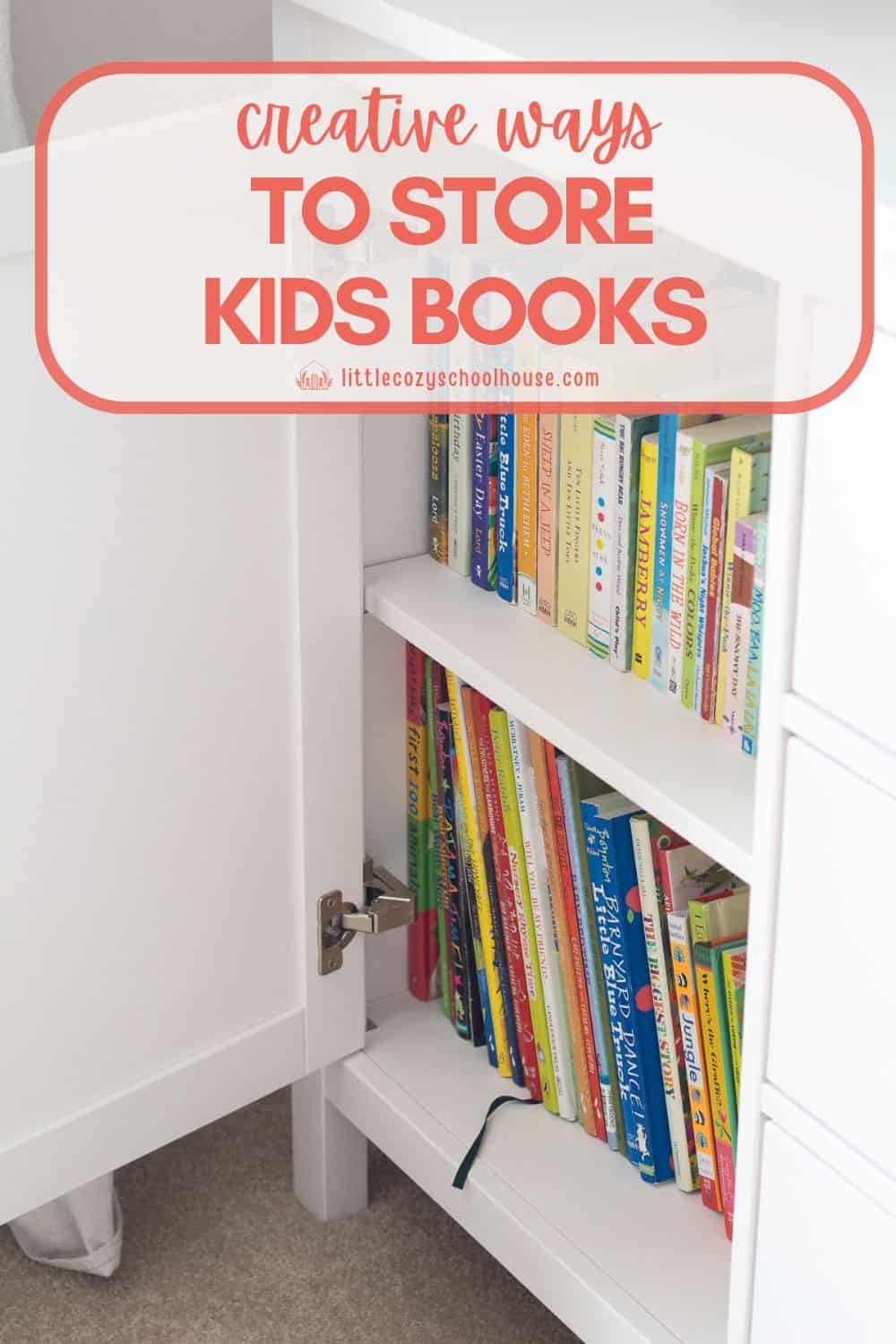
It’s amazing how quickly a small stack of board books from a baby shower becomes a formidable collection. Soon you are adding picture books, easy readers, chapter books, and even school books. Storage strategy is essential!
In this post I’ll share with you how to store children’s books–whether you are organizing board books, picture books, or chapter books.
Declutter Before Storing
Before organizing your book collections, declutter first!
I like to use sort of a modified Marie Kondo method for this. I have a lot of books so gathering them ALL into one area to sort through feels like way too much. Instead, I work through them in smaller categories: board books, then picture books, then readers, etc. etc.
I tend to get rid of books that meet any of the following criteria:
- we don’t like the book
- no one reads it
- we have a duplicate
- the book is too worn to be readable (this has happened to a board book or two)
- it’s easily available at the library (I do keep seasonal books for SURE, because the hold lists at the library are usually miles long)
- we have something better (a good criteria to cull non-fiction titles)
If you are really out of space, you’ll have to be even tougher. In that case, sometimes it’s better to go at the problem from another angle. Instead of choosing what to get rid of, choose what to keep.
Go through books selecting your only absolute favorites and then sell or donate the rest. So hard to do I know, but it’s easier to enjoy your collections when they are streamlined.
You can also opt to heavily categorize your books and then store collections in totes in a spare room or closet (if you happen to have the space). This works well if you organize by age or season.
Donating some books? Books in good condition without staining, tears, missing covers are best to donate. Avoid donating anything you wouldn’t be thrilled about finding on a thrift store shelf yourself.
Safety First
Once you’ve decluttered, it’s time to put everything back. Since we are talking books and bookshelves, it’s important to talk safety!
Books are heavy and they are often stored within even heavier furniture. Always, always, always, secure your furniture to the wall to prevent tipping! Furniture restraint kits are available online and the short amount of time it takes to install them is worth it. Protect your little ones and secure that furniture!
Note: I think this is really important to do even if you don’t have little ones living at your home. You never know when a curious visitor could tug on an unsecured bookshelf or dresser. It’s worth taking a little time to make everything safe!
Another note on safety is to avoid storing your child’s books in cupboards or drawers until they are able to manage the opening/closing without pinching their fingers (or a sibling’s). Soft fabric baskets at ground level can be a nice alternative for littles at this age.
If you do want to use cupboards or drawers for some storage, you can child-lock these areas for safety.

I also suggest avoiding any type of horizontal book stacks on shelves that the toddlers/kids would be reaching up towards. Grabbing a book near the bottom of the stack could lead to books falling down onto a toddler’s head.
I use book stacks to create little “bookends” occasionally, but only in areas that are out of reach for my toddler.

How to Store Kids Books
With the conversations of decluttering and safety out of the way, let’s chat through strategies for storing kids books and homeschool books.
Keep the Books Accessible
As you choose storage areas for your children’s books remember to keep the books accessible. Keeping books accessible is critical to developing life-long readers.
I loved watching my first toddler take book after book off of her shelves, paging through them all. This activity would easily amuse her for a half an hour or more.
Because the storage space is designated (and not overstuffed!) it’s easy to put them away again.
Rotate Your Collections
Rotating books just means dividing up your book collections and storing some of them out of the way. Then, just periodically rotate the collections, whether seasonally or just for something new.
Tip: I usually take the chance to declutter my books whenever I rotate them (usually for fall, Christmas, and spring). It’s easy to keep things fresh this way.
If you like, you can be pretty creative with your book rotations. Set up a wall of floating shelves and display seasonal books (like books about snow or gardening books). Maybe display books by a particular author or a theme (like animals, humorous books, or historical books).
Choose Your Method to Categorize Books
I find that my children’s books do not stay “organized” long! But if kids are reading, it’s really not a big deal if things don’t stay just so.
However, sometimes it’s fun to organize in different ways to keep things fresh. I especially love when it’s time to take out our favorite Christmas picture books and put those on display.
Here’s a few ways you could organize your books:
- age or grade level (board books, picture books, readers, etc)
- size (i.e. tiny board books go in a basket, while large picture books are stored in a cupboard)
- season (great for picture books)
- series
- theme/genre
- author or illustrator
Storage Solutions
If you feel like you cannot declutter another book and yet you still have limited space, it might be time to reconsider storage solutions.
From obvious solutions (like children’s bookshelves) to utilizing what your home itself might have to offer (built-ins or even closets) there are plenty of options for storing children’s books.
Build your own built-in cabinets
This is my favorite option for storing kids books! Home built-ins are sturdily secured to the walls already and they are often built with cupboards on the bottom and shelves on the top. If your toddlers/kids can handle opening/closing the cupboard doors without incident, this can be a great place to store their books.
We installed these IKEA HAVSTA storage units as built-ins in our basement. I filled them more quickly than I thought possible! Time to declutter again.
Important: If you go this route and make your own built-ins, you do need to secure them to the wall to prevent tipping.
I like the glass doors on these cabs for protecting collections from dust. You can also get a solid door version which is fantastic if you love a minimalist look.
We ended up adding more of these in our spare bedroom and we went with the solid-door version and love them. Best storage ever!
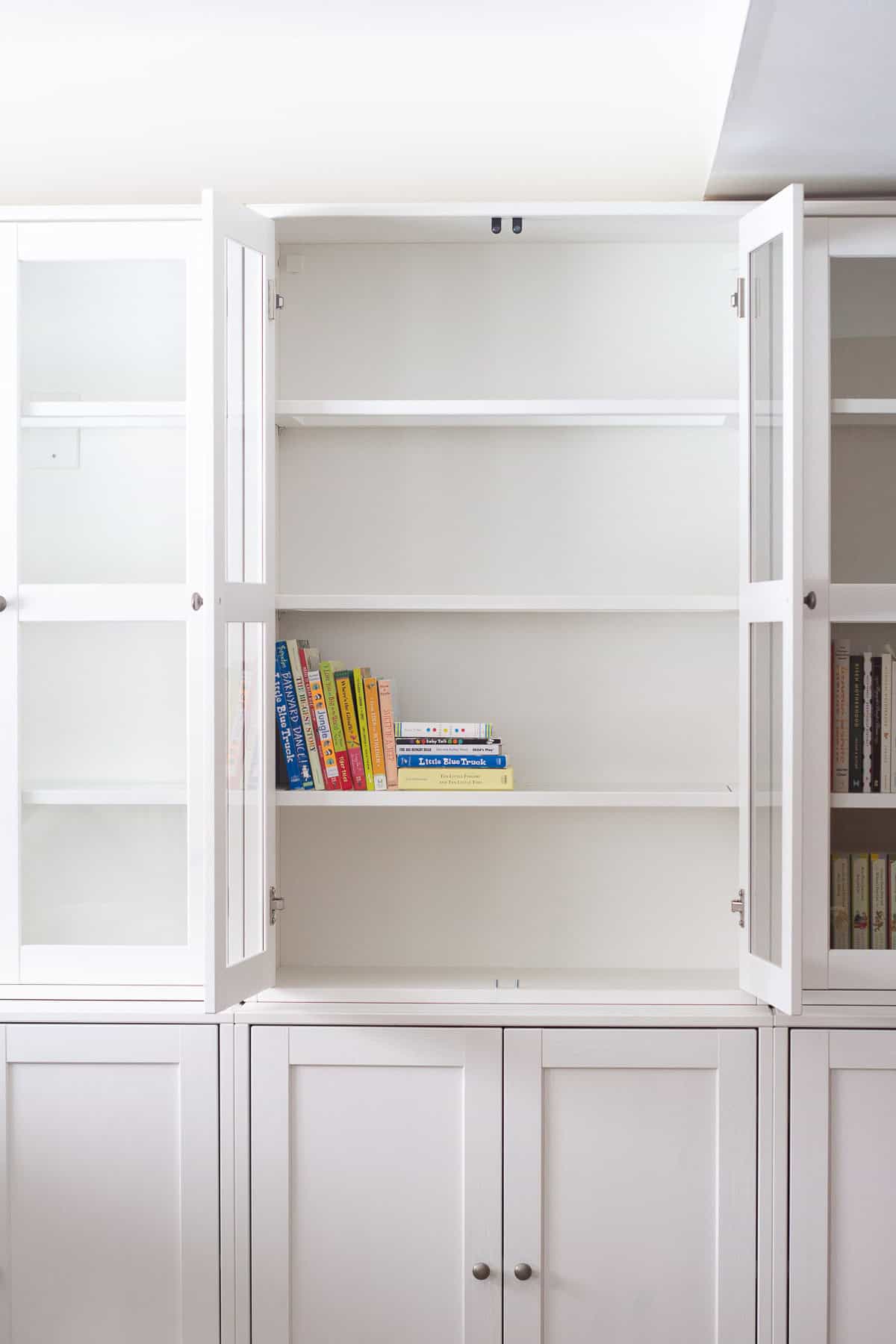
Utilize a sideboard or credenza
Also try using pieces like the HEMNES sideboard piece from IKEA. A vintage credenza would be really lovely too. If you have a spare wall, find a secondhand piece with cupboards and then utilize it for books.
Homeschooler’s tip: If you have a credenza or sideboard, you can also use the top to prep and “stage” your schoolbooks for the following day. I hate having countertop clutter, but having books set off to the side is a great way to start school efficiently and keep books off the breakfast table.
We used our sideboard for baby toys and books and we’ve now transitioned it to a homeschool storage area as well as picture book storage.
This year I’ll be using some vertical magazine storage containers for our morning time books and some workbooks. I’m excited to have things well-organized. I’ll do a separate post on that with updated photos.

Tip: Remember to secure furniture to the wall for safety.
Oftentimes we turn to a traditional open bookshelf for storing books, but these can become visually cluttered and overwhelming.
Minimizing visual clutter: What’s great about built-ins and credenzas for storage is that the books can stay behind the cupboard doors and your space will instantly look tidier.
Kids books come in SO many colors, sizes, and even shapes that sometimes keeping those bright stacks behind a cupboard can be a nice way to manage the aesthetics of the collections.
Color-code your books: Good luck keeping books color-coded with eager reads around, but if you enjoy keeping up with it, it is another fun way to store books–especially large collections.
Use bookshelves
If you already have bookshelves, utilize them! For a neater look, keep books together by size/style (such as board books, picture books, chapter books, series, etc).
Keep the shelves dusted and intersperse some pretty faux plants or simple décor to break up the shelves visually.
A bookcase can also be a fun addition to children’s bedrooms. Oftentimes a small shelf can sneak in under a window or inside a closet and yield a little extra storage space.

Don’t forget about dresser drawers
After the baby stage was over, I realized that my daughter’s dresser was becoming quite empty. We no longer needed dozens of onesies, burp cloths, the baby carriers, or the next size up in clothing standing by.
Those empty drawers provided the perfect storage solution to the stuffed animal and board book problem that was becoming out of hand!

Now that we have two kids sharing a dresser, we don’t have room for this anymore, but it was handy while it lasted. Try decluttering a dresser (we all have plenty of clothing we no longer wear or need) and see if you can find a drawer or two to store small books inside.
Display Kids Books on Floating Shelves for Seasonal Displays & Rotations
Floating shelves or floating ledges can be a great way to display seasonal books. The shelves allow each book cover to be visible. These pretty displays can encourage reluctant readers.
We grabbed some extra space by installing these shelves in our stairwell. I currently have our shelves set up with family photos, but they work with picture books too.
If we eventually have more space for a dedicated schoolroom, I’d like to install more of these shelves to display picture books that we are using for unit studies or holiday reading.
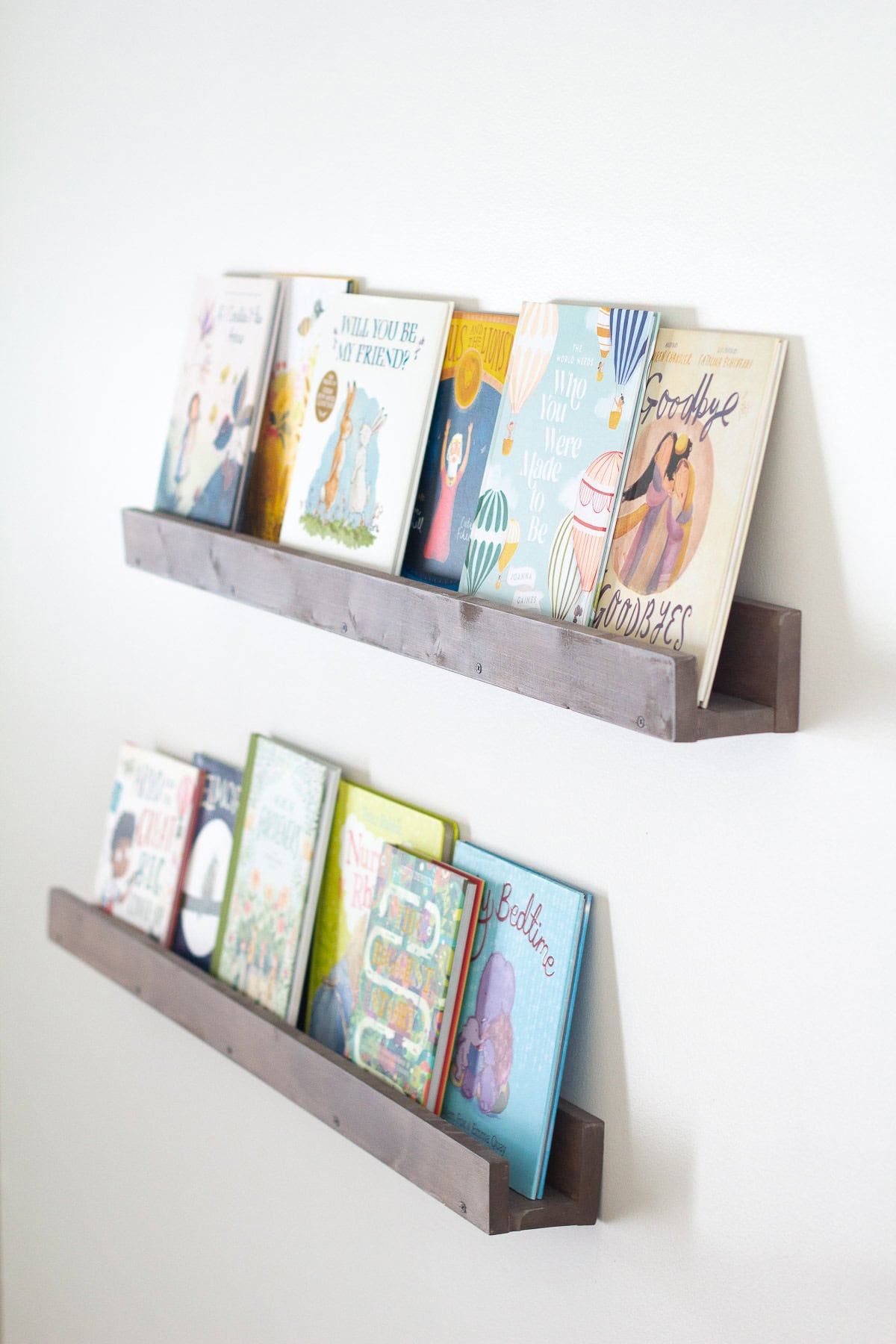
Wall cubbies
I picked up these wall cubbies/floating shelves from Hobby Lobby and I think the scalloped edge is just the cutest. These smaller cubbies are great if you don’t have the room for larger floating shelves.
These are good for board books. If you are short on space though, I would opt to use a corner like this for a bookshelf or something with more overall storage.
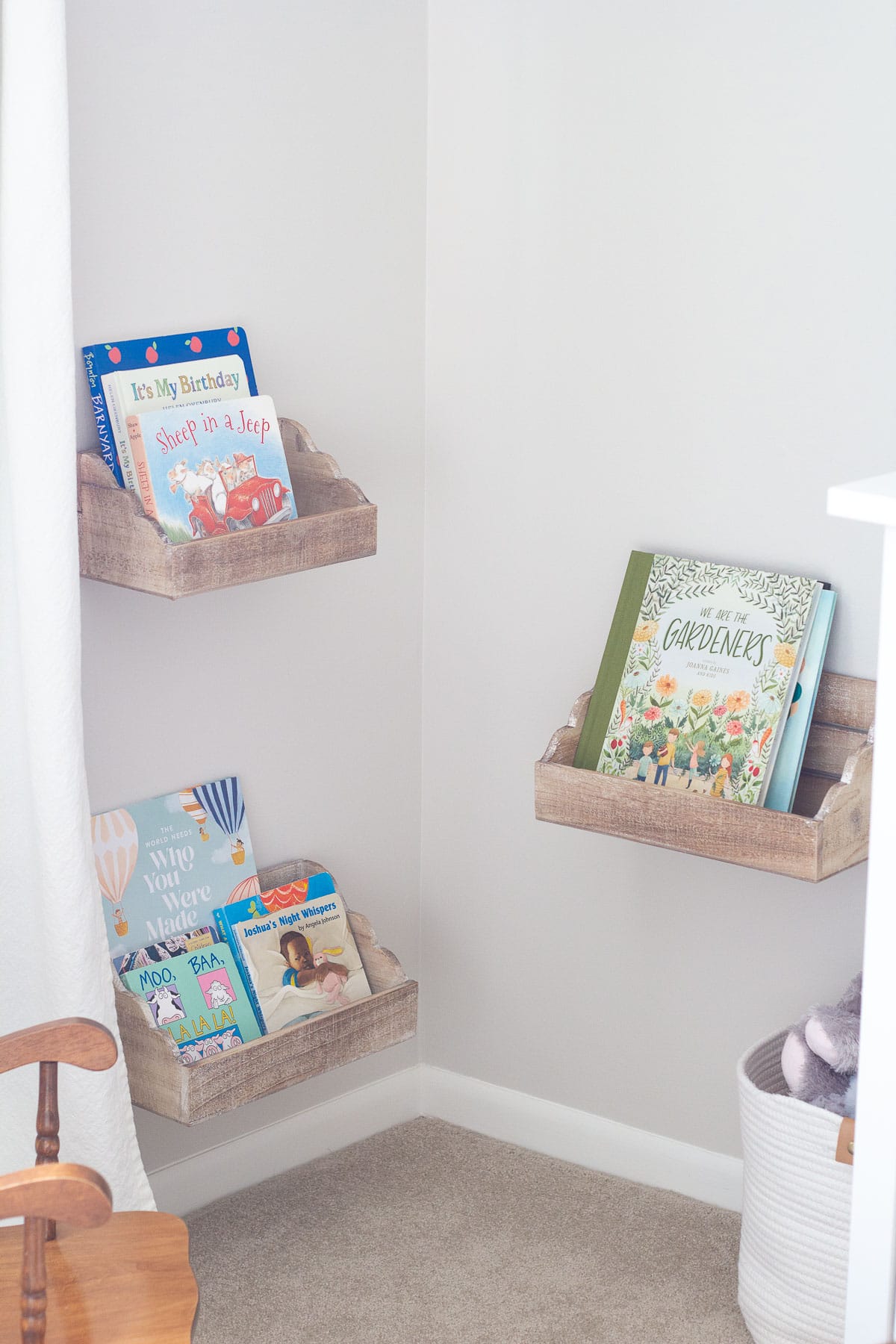
Hobby Lobby probably doesn’t have these exact shelves anymore, but they usually carry similar products.
Another popular idea is to use the IKEA Spice Racks. They are small, so you won’t be able to store many books in them, but they are also quite inexpensive. You can see how they look with books over here!
I used a large wall box shelf to add a little storage to the top of our dresser. Just a small way to corral a few extra books or toys.
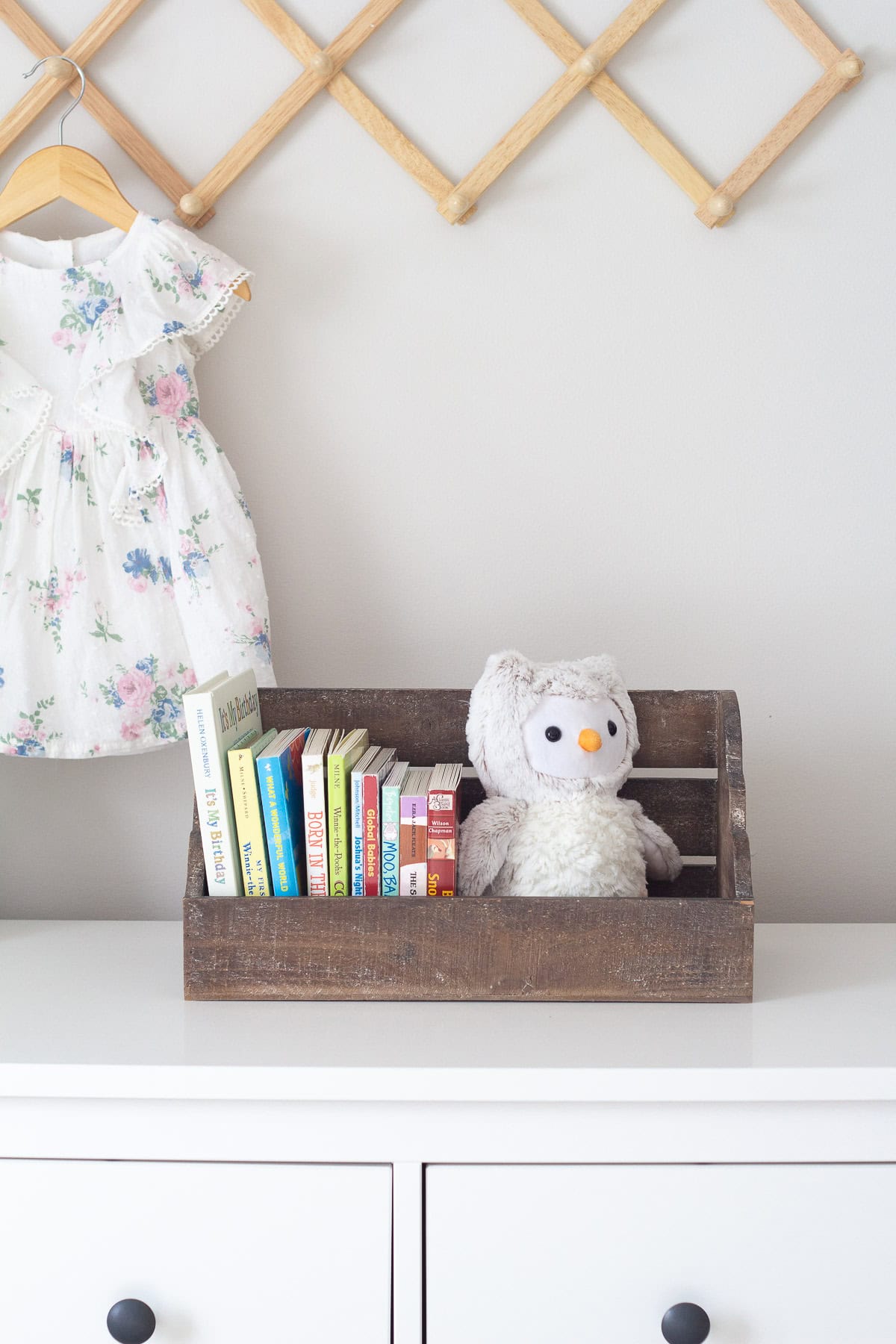
Corral books into baskets
Nearly all of us have an extra basket or two lying around. Tuck a basket near a favorite couch, chair, or in your little one’s bedroom with a few of your favorite reads. Scattering books around the home is a great way to embrace reading aloud all throughout the day!
Make a “Morning Basket”: Homeschoolers often arrange a “morning basket” of family curriculum like hymn studies, picture books, Bible lessons, or whatever! Baskets keep these picks in one area ready-to-go.
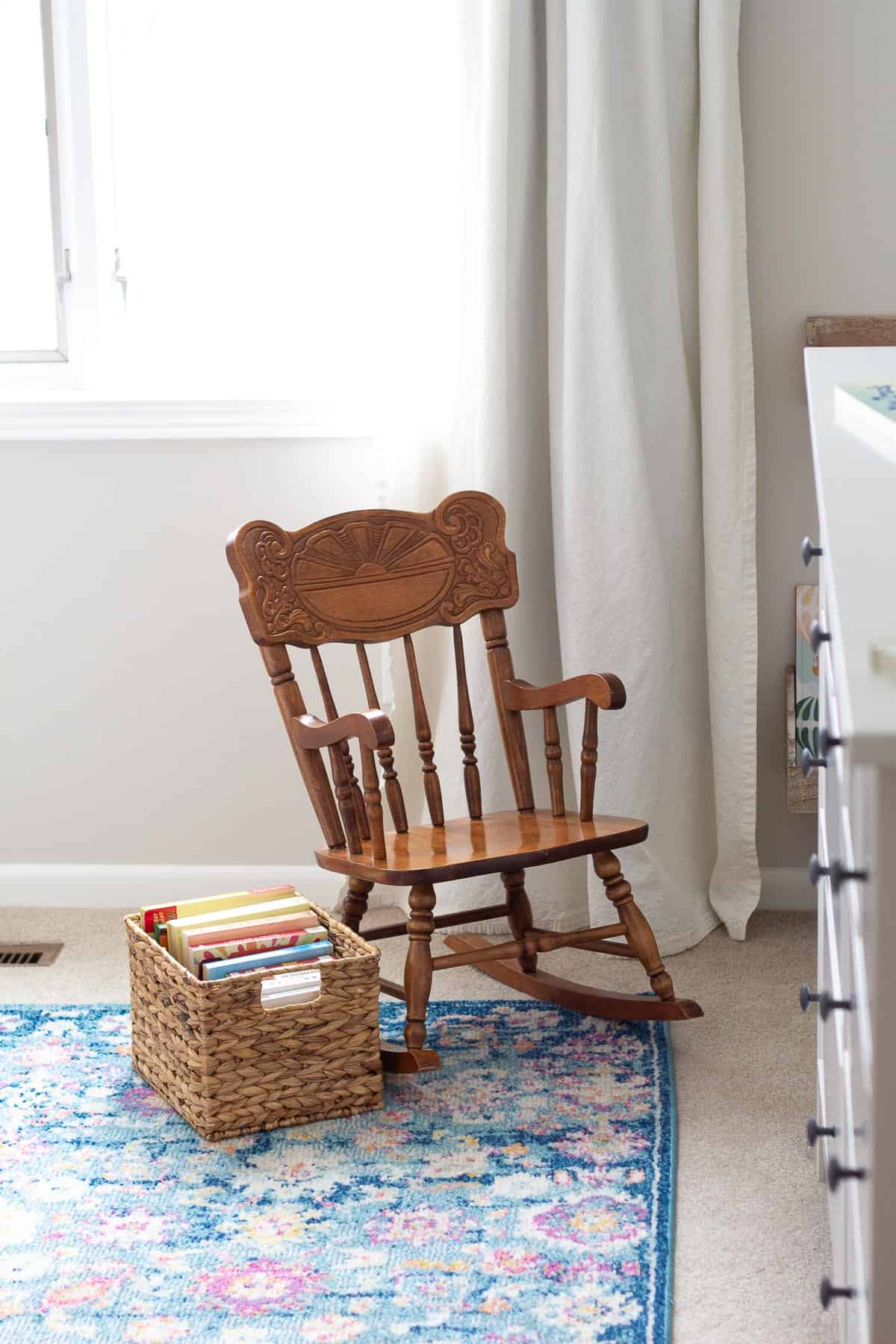
Storing Books Long-Term
Homeschoolers are always storing curriculum and books for future use. It keeps the school areas clean and focused on the work at hand. Storing all these “extras” can get overwhelming though.
I’m still figuring this out for myself, so I hope to share more ideas for longer-term storage in the future.
A few things to consider though:
- keep books clean and dry
- air-tight containers are better than cardboard boxes or open storage
- avoid garages or basements
- organize books and label clearly so you can find what you need
- declutter first–no need to store books you won’t need
- trade books back-and-forth with other families instead of storing them (use bookplates for easy identification and don’t pass along anything that you will be upset about if it doesn’t come back)
Let me know your solutions for storing kids books! I’d love to hear from you!
